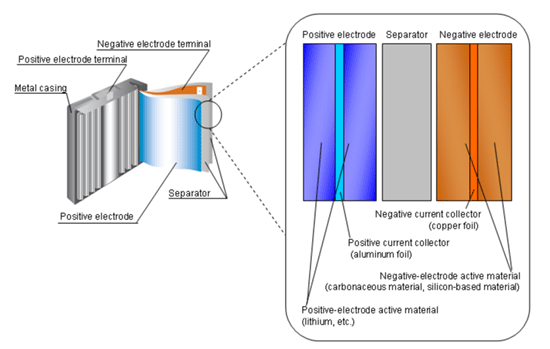2010 The former Hitachi Cable News Release
Information (including product prices, product specifications, details of services, launch dates, inquiry information, and URLs) contained in this news release is current as of the date of the press release but is subject to change without notice. Please note that details may differ from those effective on the search date.
Hitachi Cable develops high-strength, high-temperature-resistant rolled copper foil for next-generation lithium-ion secondary batteries
Hitachi Cable, Ltd. has announced the development of a high-strength, high-temperature-resistant rolled copper foil for use in next-generation lithium-ion secondary batteries (hereafter referred to as "lithium-ion batteries"), using alloys such as silicon alloys as the negative-electrode active material.*1
Offering high energy density, compact dimensions, and light weight, lithium-ion batteries are widely used in mobile devices. Lithium-ion batteries in recent years have also entered use as power sources for hybrid vehicles. Current development efforts in this area also target use as accumulator batteries for wind and photovoltaic power generation. These are among the growing roles this technology is expected to fill.
Since 1997, Hitachi Cable has manufactured rolled copper foil for use as negative-electrode materials in lithium-ion batteries, drawing on rolling technologies developed during its production of copper strips. Our rolled copper foil products are widely used in consumer products, including various portable devices. The company has also begun mass production of rolled copper foil for use in automotive electronics, another area in which such products are expected to find expanding use.
Recent mobile devices, including notebook PCs and smartphones with high-performance CPUs and GPUs,*2 tend to consume more electricity than earlier products, creating burgeoning demand for lithium-ion batteries with higher energy densities. One approach to achieving high energy density is to use alloys such as silicon alloys, which offer higher charge/discharge capacities than today's mainstream carbonaceous materials, as the negative-electrode active material applied to the copper foil surface of negative current collectors. However, alloy materials undergo greater volumetric changes than carbonaceous materials during the charge/discharge cycle. Repeated charge/discharge cycles generate stress in the copper foil, eventually causing the copper foil to separate from the negative-electrode active material and reducing battery lifespan. Solving this problem required the development of a high-strength copper foil capable of withstanding volumetric fluctuations.
To extend the service life of next-generation lithium-ion batteries, Hitachi Cable is drawing on this alloy to create a high-strength, high-temperature-resistant rolled copper foil for use as a negative-electrode active material that offers the required strength and heat resistance.
The copper foils used as negative-electrode materials in lithium-ion batteries are generally restricted to a thickness of 8 to 10 micrometers to provide the high energy density needed within a limited form factor. Next-generation lithium-ion batteries will require copper foils of about the same thickness. To develop this new copper foil, Hitachi Cable selected HCL02Z*3 copper alloy, a material that offers both high durability and excellent workability. HCL02Z copper alloy contains 0.02% zirconium and provides greater strength and heat resistance than the high-purity rolled copper foils or electrolytic copper foils widely used as conventional negative electrode materials. This copper alloy resists softening and retains high strength during lithium-ion battery manufacturing processes. The resulting rolled copper foil is also surface-treated to improve contact characteristics with the negative-electrode active material. Evaluations of prototype batteries demonstrate that the new rolled copper foil remains free of plastic deformation while offering a battery life over 10% longer than provided by batteries incorporating the conventional electrolytic copper foil.
The development of high-strength, high-temperature-resistant rolled copper foils capable of withstanding volumetric changes in alloy negative-electrode active materials will result in rapidly expanding use of next-generation lithium-ion batteries in consumer products, including mobile devices. These batteries will also stimulate demand for automotive applications, including hybrid vehicles. Hitachi Cable intends to pursue energetic efforts to develop and refine rolled copper foils to support this expanding range of applications.
| *1 | The active material in a battery releases and accepts electrons through chemical reactions with the battery electrolyte. |
| *2 | GPU: Graphics Processing Unit. |
| *3 | HCL is a registered trademark of Hitachi Cable, Ltd. |
Typical characteristics of HCL02Z copper alloy
| Composition | Zr: 0.02, Cu: Remaining portion |
|---|---|
| Tensile strength(N/m m2) | 450 |
| Electric conductivity (%IACS) | 97 |
| Thickness(µm) | 6min. |
| Width (mm) | 570max. |
Reference: Structure of lithium-ion battery
